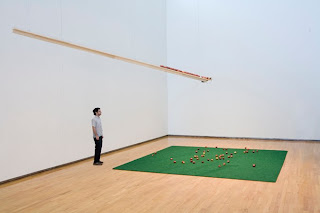Quotation
"I am interested in the contradiction between the abstract notion of secrecy and the physical materiality of [its institutions]...all matter reflects light."
This quote was really interesting to me because this contradiction is parallel to the contradiction I noticed in the materiality of Paglen's physical art objects. He uses the term "photography" in quotations, hesitant to label his work this way. The reason is that photography implies a documentation of some truth and the tools which Paglen uses physically manipulate that truth by being almost
too true. He has lenses he can use to photograph something 40 miles away, which seems as though it is true documentary photography, however, the distortion creating artistic interest blurs the line between a document and an abstraction. I think this quote is the conceptual equivalent of what Paglen's work is doing in a physical (process) form.
3 Words
1) Truth
2) Abstraction
3) Collapse
About Paglen
What I did not know about Paglen before the lecture is that he drew inspiration from the early Department of War photographers, who scouted the American landscape. He made an interesting comparison to himself as an artist and his inspirational predecessors by saying that their work was a metaphor to today's spy satellites, which he is exposing by acting like a spy "photographer." The question is then suggested: "Who is the spy?"
Answers
My first question about the specialized equipment Paglen uses and how it affects the work was discussed above. The concept of the work is furthered by the functioning of the materials used. Paglen really sidestepped the questioning of his image capturing tools, making it seem as though they are a means to an end. However, it was clear the way he discussed the "collapsing into the abstract," that material process affected this contradiction between the abstract and the true document.
My second question concerned Paglen's definition, and what defined his work as fine art. The answer to this question was obvious just by listening to him speak about concept and implications of materiality and the cultural landscape contextualizing his work. At the end of his lecture, Paglen answered a similar question about his purpose by saying, "What I want out of art, science and scholarship is to show stuff that helps us see who we are now."
Compelling Piece
Paglen's "Limit Telephotography" work, I found to be really compelling. I discussed the materiality of this work above, in the discussion of abstracting with truth. I find the photographic roots of this exploration fascinating and timely. Paglen's "documentation" "collapses" the document into abstraction, "making the viewer encounter their own inability to make sense of something." This work is so compelling because the same way we encounter this inability with viewing the physical work, we are looking at an institution designed to make us unaware of this inability. In business, we often say the most threatening knowledge is that which we don't know that we don't know: the unknowable. In a lot of ways, Paglen is representing this awakening to the state-imposed unknowables.

Chemical and Biological Weapons Proving Ground
Dugway, UT
Distance ~ 42 miles
10:51 a.m.




















